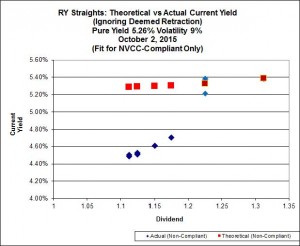Royal Bank of Canada has announced:
it has closed its domestic public offering of Non-Cumulative, Preferred Shares Series BJ. Royal Bank of Canada issued 6 million Preferred Shares Series BJ at a price of $25 per share to raise gross proceeds of $150 million.
The offering was underwritten by a syndicate led by RBC Capital Markets. The Preferred Shares Series BJ will commence trading on the Toronto Stock Exchange today under the ticker symbol RY.PR.P.
The Preferred Shares Series BJ were issued under a prospectus supplement dated September 28, 2015 to the bank’s short form base shelf prospectus dated December 20, 2013.
RY.PR.P is a PerpetualDiscount, 5.25%, announced September 24. The issue will be tracked by HIMIPref™ and has been assigned to the PerpetualDiscount subindex.
The issue traded a miserable 73,494 shares today (consolidated exchanges) in a range of 24.40-80 before closing at 24.40-44, 15×29. Vital statistics are:
| RY.PR.P | Perpetual-Discount | YTW SCENARIO Maturity Type : Limit Maturity Maturity Date : 2045-10-02 Maturity Price : 24.04 Evaluated at bid price : 24.40 Bid-YTW : 5.39 % |
When only the NVCC-compliant issues are used for fitting the Implied Volatility curve, it appears that Implied Volatility is very low (which suggests that the relationship will steepen somewhat in the future) implying that higher-coupon issues are relatively expensive. However, there are only four data points to support this conclusion and the variety of coupon rates is minimal, so don’t mortgage the farm!
On the other hand, the lower-coupon, explicitly NVCC-compliant issues (RY.PR.N and RY.PR.O) are trading at the same Current Yield at the new issue, which is crazy; they should be trading to yield a little less (with the 9% Implied Volatility shown, which is calculated including the NVCC-compliance-eligible RY.PR.W), the difference in Current Yield should be about 6bp.

Hi James
Considering the low price of some of the floating prefers and fixed reset prefers lately, do you see some banks (and maybe insurance companies) looking at purchasing some shares of non compliant NVCC issues in the market for cancellation?
Another question: if a prefer is issued at $25 but repurchased on the market for cancellation at $17 what is the accounting treatment of it?
Thanks for you very instructive blog.
do you see some banks (and maybe insurance companies) looking at purchasing some shares of non compliant NVCC issues in the market for cancellation?
It hasn’t happened yet, so I don’t think it will happen.
I suspect that reluctance by regulated entities is related to the necessity of getting permission from OSFI. If they were to buy back via a NCIB (like Fairfax and Brookfield Renewable) this would involve getting a one-year window from the TSX; OSFI might get very nervous regarding giving permission to buy back Tier 1 Capital a year in the future. But I don’t know.
Insurers might also face criticism based on insider information regarding the likelihood of the imposition of the NVCC rules.
if a prefer is issued at $25 but repurchased on the market for cancellation at $17 what is the accounting treatment of it?
In the case of the YLO buy-back the discount was taken into income via “Financial Charges”. See SEDAR, “Yellow Pages Digital & Media Solutions Limited Aug 4 2011 10:34:25 ET Interim financial statements/report – English PDF 204 K”, a document to which I am not permitted to link directly because the regulators want to keep the public documents from the public.
As to whether that is the only permissible way to treat it … you’ll have to ask an accountant!